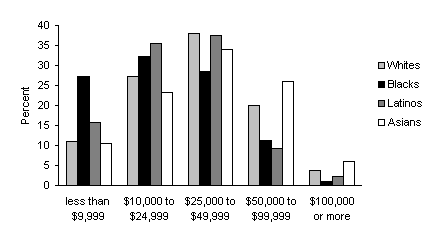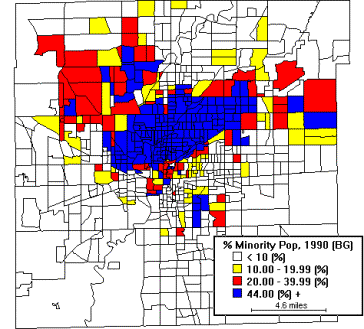
The Decision to Prosecute Drug Offenses and Homicides in Marion County, Indiana
Chapter 1
Introduction
The criminal justice system has three major components that qualitatively and quantitatively affect minority communities: (1) policing and the provision of police services, (2) prosecution decisions, and (3) the courts and sentencing decisions. Policing and the provision of police services involve such issues as deployment decisions, use of excessive force, police officer sensitivity, response time, and policing strategy. Courts and sentencing decisions include issues such as bail amounts, conviction rates, parole decisions, and sentence lengths.
The U.S. Commission on Civil Rights has studied aspects of policing and the provision of police services as well as issues regarding court and sentencing decisions. The issue of decisions to prosecute and whether such decisions adversely affect minority communities has not been studied by the Commission. It is a particularly pertinent issue for study because there appears to be a perception within minority communities that minorities are disproportionately prosecuted.
The Indiana Advisory Committee to the U.S. Commission on Civil Rights decided to examine the issue of prosecution discretion. The Committee decided to study prosecution decisions in Marion County for the years 1993 and 1997.
Marion County was selected not because of any particular allegation or conclusion that prosecution decisions are racially biased, but rather strictly due to (1) the county's size (it is the most populous county in the state); (2) its proximity to the state capital the city of Indianapolis, also the county seat for Marion County; (3) available computerized data; (4) the diversity of population within the county; and (5) the fact that the two most recent prosecutors have been from both major political parties.
Two types of charging decisions are included in this report: the prosecution of drug offenses and the prosecution of homicides. Homicides are the most serious prosecution cases, and drug offenses offer particular insight into whether minorities are targeted for prosecution, because such offenses are the most numerous violations for arrest, prosecution, and incarceration in Marion County.
In the two years studied, 1993 and 1997, 7,282 individuals were arrested for possession of narcotics or controlled substances, and another 1,892 were arrested for dealing narcotics or controlled substances. In 1993 and 1997, 279 individuals were arrested for attempted murder, involuntary manslaughter, or murder.
Although the original study design included homicides, because prosecution numbers and arrest numbers are highly coincident and some of the information pertinent to the prosecution decision process was unavailable for analysis, an analysis of homicide prosecution decisions would have rendered invalid and unreliable results. Therefore, the technical aspects of this study are limited to drug offenses. However, testimony concerning the decision to prosecute homicides is included in chapter 2, and homicide arrest and prosecution data are included in the data analysis in chapter 3.
DEMOGRAPHICS OF MARION COUNTY
Marion County is located in central Indiana. It is the most populous county in the state, with a population of 836,610,[1] and is home to the state's capital, Indianapolis. Whites and African Americans compose 98 percent of Marion County's population, though there are Asian and Latino residents in the county.
The Census Bureau estimates the Marion County population in 1997 to have increased by 5 percent since the 1990 census, and includes 641,680 whites (76.7 percent); 177,361 African Americans (21.2 percent); 9,148 Hispanics (1.4 percent); and 8,316 Asian Americans (0.7 percent).[2] The percentages of whites, African Americans, Latinos, and Asian Americans in Marion County are estimated to be the same in 1997 as in 1990.[3]
According to 1990 census data, African American and Latino households in Marion County earn significantly less income than white and Asian households. Sixty percent of African American households in Marion County have an income less than $25,000, and 50 percent of Latino households have an income lower than $25,000. Less than 40 percent of white and Asian households in Marion County have incomes below $25,000. Moreover, almost one-fourth (23.8 percent) of white households in the county have an income exceeding $50,000 (see table 1.1 and figure 1.1).
|
TABLE
1.1 |
||||
|
Income |
Whites |
Blacks |
Latinos |
Asians |
| < $9,999 | 11.0% | 27.2% | 15.7% | 10.6% |
| $10,000 $24,999 | 27.3% | 32.2% | 35.4% | 23.2% |
| $25,000 $49,999 | 37.9% | 28.4% | 37.4% | 34.1% |
| $50,000 $99,999 | 20.1% | 11.3% | 9.2% | 26.0% |
| > $100,000 | 3.7% | 0.9% | 2.3% | 6.1% |
|
Source: Midwestern Regional Office, U.S. Commission on Civil Rights, from 1990 U.S. census data. |
||||
Despite recent desegregation trends to the northern parts of the county, i.e., the townships of Pike, Washington, and Lawrence, most of the African American population remains concentrated in the central part of Marion County, particularly the north central portion of the original city of Indianapolis. This area is bounded by downtown Indianapolis on the south, 38th Street on the north, Sherman Street to the east, and High School Road to the west. Figure 1.2 shows the African American population of the county by census blocks.
DRUG ARRESTS, PROSECUTION, AND INCARCERATION
In the late 1960s Marion County adopted a Unigov form of government. Under the Unigov structure, formerly independent municipalities merged into one countywide operating government structure. As a result, there is a sole county prosecutor in the county elected by all county residents.[4]
ORGANIZATION OF REPORT
The study has two parts. The first part sets out public testimony in two sections of chapter 2. The first section of public comment is from the two most recent county prosecutors: Scott Newman (R), current Marion County prosecutor since 1995; and Jeffrey Modisett (D), Marion County prosecutor from 1991 to 1994 and who was attorney general for the state of Indiana at the time of the study. The second section of public comment is primarily commentary from members of the African American community regarding their perceptions on the fairness of the prosecution decisions with respect to minorities. Public comment is set out in chapter 2.
The second part of this study is data analysis, which is presented in chapter 3. The findings and recommendations of the Indiana Advisory Committee are found in chapter 4.
Methodology and Data Limitations
Statistical analyses were conducted to determine if race and/or ethnicity was a factor associated with the decision to prosecute in arrests for possession and/or distribution of controlled substances in 1993 and 1997. First, a chi-square test was conducted to test for independence between race and homicides and arrests. Second, regression analyses were conducted to test the relationship between the decision to charge or not charge and individual and other variables, such as race. The results are shown in chapter 3.
Arrest data for drug offenses and homicides were obtained from the Marion County Criminal Justice Information Agency and law enforcement agencies in Marion County. Unfortunately, the data did not allow for a complete analysis. For example, when matching arrest data with prosecution data, only 67 percent of the cases were able to be matched by case identification number. Similarly, data on education and income levels of arrestees had to be omitted from analyses because of missing data.
FIGURE
1.1
Household Income by Race and Ethnicity in Marion County

Source: Midwestern Regional Office, U.S. Commission on Civil Rights, from U.S. census data.
FIGURE
1.2
Minority Population of Marion County by Census Block

Source: Midwestern Regional Office, U.S. Commission on Civil Rights.
[1]
U.S. Department of Commerce, Bureau of the Census, 1997 population
estimates.
[2]
Ibid.
[3]
1997 census update. Marion County Prosecutor Scott C. Newman states in his
response letter, included as an appendix, that a recent influx of
Hispanics to the (Marion County) community has caused that ethnic group s
population percentage to rise to approximately 8.3% of all residents in
Marion County.
[4] Under the Unigov structure, the police force was separated into two groups. The Indianapolis Police Department patrols the area of Marion County containing the original boundaries of the city of Indianapolis, while the Marion County Sheriff's Department polices the area of Marion County outside the original boundaries of Indianapolis. The Marion County prosecutor, however, is responsible for prosecuting charges made by both the Indianapolis Police Department and the Marion County Sheriff's Department.